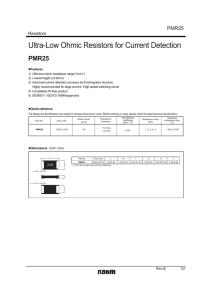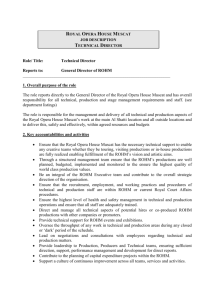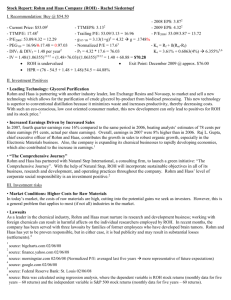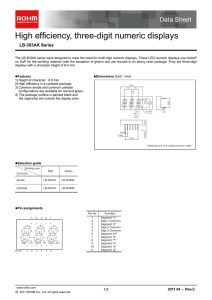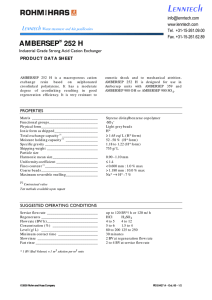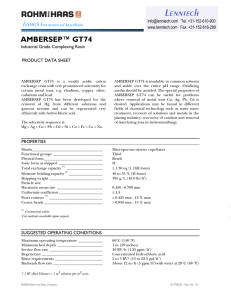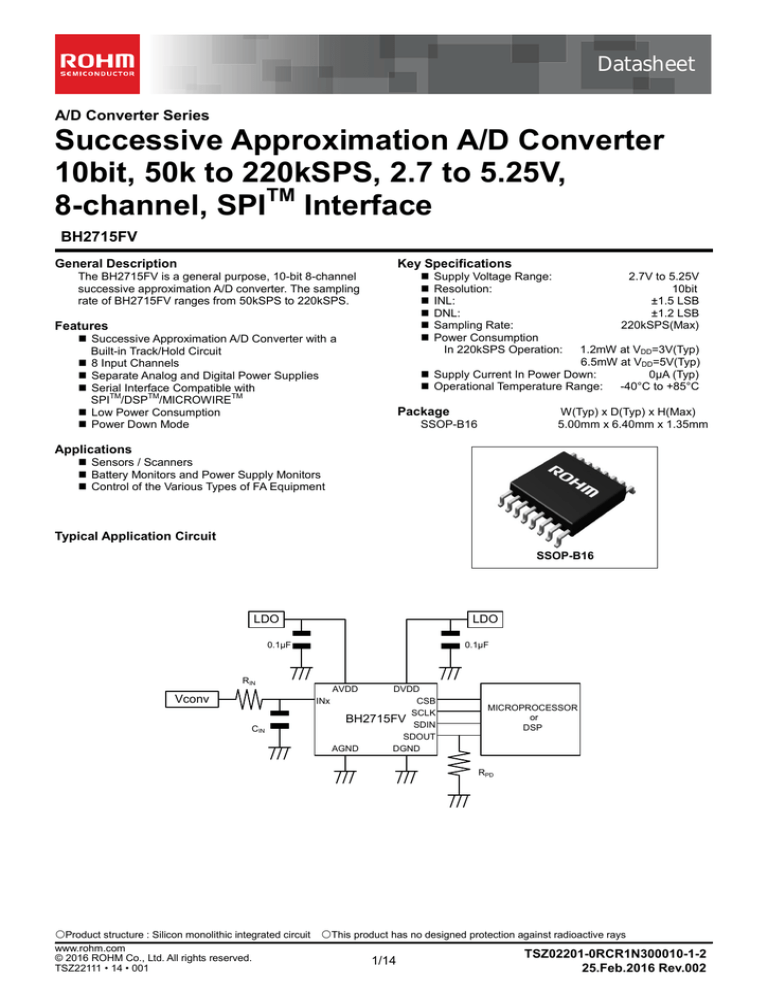
Datasheet
A/D Converter Series
Successive Approximation A/D Converter
10bit, 50k to 220kSPS, 2.7 to 5.25V,
8-channel, SPITM Interface
BH2715FV
Key Specifications
General Description
The BH2715FV is a general purpose, 10-bit 8-channel
successive approximation A/D converter. The sampling
rate of BH2715FV ranges from 50kSPS to 220kSPS.
Features
Successive Approximation A/D Converter with a
Built-in Track/Hold Circuit
8 Input Channels
Separate Analog and Digital Power Supplies
Serial Interface Compatible with
TM
TM
TM
SPI /DSP /MICROWIRE
Low Power Consumption
Power Down Mode
Supply Voltage Range:
Resolution:
INL:
DNL:
Sampling Rate:
Power Consumption
In 220kSPS Operation:
2.7V to 5.25V
10bit
±1.5 LSB
±1.2 LSB
220kSPS(Max)
1.2mW at VDD=3V(Typ)
6.5mW at VDD=5V(Typ)
Supply Current In Power Down:
0µA (Typ)
Operational Temperature Range:
-40°C to +85°C
Package
W(Typ) x D(Typ) x H(Max)
5.00mm x 6.40mm x 1.35mm
SSOP-B16
Applications
Sensors / Scanners
Battery Monitors and Power Supply Monitors
Control of the Various Types of FA Equipment
Typical Application Circuit
SSOP-B16
LDO
LDO
0.1μF
0.1μF
RIN
Vconv
AVDD
INx
CIN
DVDD
CSB
SCLK
BH2715FV SDIN
SDOUT
AGND
DGND
MICROPROCESSOR
or
DSP
RPD
〇Product structure : Silicon monolithic integrated circuit
www.rohm.com
© 2016 ROHM Co., Ltd. All rights reserved.
TSZ22111 • 14 • 001
〇This product has no designed protection against radioactive rays
1/14
TSZ02201-0RCR1N300010-1-2
25.Feb.2016 Rev.002
BH2715FV
Pin Configuration
SSOP-B16
(TOP VIEW)
16 15 14 13 12 11 10 9
1 2 3 4 5 6 7 8
Pin Descriptions
Pin No.
Pin Name
Description
1
CSB
Chip select input terminal. Logic input in active-low. The falling edge of CSB starts A/D
conversion.
2
AVDD
Analog power supply terminal.
3
AGND
Analog ground terminal.
4
IN0
Analog input terminal. Input range : 0 to VA[V].
5
IN1
Analog input terminal. Input range : 0 to VA[V].
6
IN2
Analog input terminal. Input range : 0 to VA[V].
7
IN3
Analog input terminal. Input range : 0 to VA[V].
8
IN4
Analog input terminal. Input range : 0 to VA[V].
9
IN5
Analog input terminal. Input range : 0 to VA[V].
10
IN6
Analog input terminal. Input range : 0 to VA[V].
11
IN7
Analog input terminal. Input range : 0 to VA[V].
12
DGND
Digital ground terminal.
13
DVDD
Digital power supply terminal.
14
SDIN
Serial data input terminal to set a register.
15
SDOUT
Serial data output terminal. SDOUT outputs serial data synchronously to the falling
edge of SCLK. In the 16-bit serial data, the first 4 bits are zeros, the following 10-bit
data is an A/D conversion result in MSB first and the last 2 bits are zeros.
16
SCLK
Clock input terminal. Controlling serial data output and A/D conversion processing.
www.rohm.com
© 2016 ROHM Co., Ltd. All rights reserved.
TSZ22111・15・001
2/14
TSZ02201-0RCR1N300010-1-2
25.Feb.2016 Rev.002
BH2715FV
Block Diagram
SCLK SDOUT SDIN
16
15
14
DVDD DGND
13
IN7
IN6
IN5
11
10
9
12
AVDD
DVDD
+
T/H
Control
Logic
10bit Charge
Redistribution
DAC
DGND
1
CSB
2
MUX
-
3
AVDD AGND
AGND
4
5
6
7
8
IN0
IN1
IN2
IN3
IN4
1. MUX(Analog Multiplexer)
MUX is a group of analog switches which connects one of the input terminals IN0 through IN7 to the Track/Hold circuit
for A/D conversions. MUX is controlled by the 3-wire serial interface.
2. T/H(Track/Hold circuit)
Track/Hold circuit tracks the input terminal voltage before A/D conversion starts, and the input voltage is held just after
the A/D conversion starts. Even if the terminal voltage changes in the A/D conversion, it is possible to convert correctly
the input voltage which is captured just as the A/D conversion starts.
3. 10bit Charge-Redistribution DAC
The capacitor type D/A converter with the 10 bit resolution. It gives a comparison voltage for A/D conversion to the
voltage comparator.
www.rohm.com
© 2016 ROHM Co., Ltd. All rights reserved.
TSZ22111・15・001
3/14
TSZ02201-0RCR1N300010-1-2
25.Feb.2016 Rev.002
BH2715FV
Absolute Maximum Ratings (TA=25°C)
Parameter
Symbol
Ratings
Unit
VDD
-0.3 to +6.5
V
Analog Input Voltage
VIN ANA
-0.3 to VDD+0.3 ≤ +6.5
V
Digital Input Voltage
VIN DIG
-0.3 to +6.5
V
Supply Voltage
Power Dissipation
Unmounted
0.40
(Note1)
mounted
0.70
(Note2)
PD
W
Junction Temperature
TJmax
125
°C
Storage Temperature
Tstg
-55 to +125
°C
(Note 1) Derate by 4.0mW/°C when operating above TA=25°C. (Unmounted on a PCB board)
(Note 2) Derate by 7.0mW/°C when operating above TA=25°C. (when mounted on a 70mm×70mm×1.6mm, 1-layer, glass-epoxy board.)
Caution: Operating the IC over the absolute maximum ratings may damage the IC. The damage can either be a short circuit between pins or an open circuit
between pins and the internal circuitry. Therefore, it is important to consider circuit protection measures, such as adding a fuse, in case the IC is operated over
the absolute maximum ratings.
Recommended Operational Conditions
Parameter
Symbol
Ratings
Unit
Analog Supply Voltage
VA
2.7 to 5.25
V
Digital Supply Voltage
VD
2.7 to 5.25
V
Analog Input Voltage
VIN ANA
0 to VA
V
Digital Input Voltage
VIN DIG
0 to 5.25
V
fSCLK
0.8 to 3.52
MHz
fSAMPLE
50 to 220
kSPS
Topr
-40 to +85
°C
Clock Frequency
Sampling Rate
Operational Temperature
www.rohm.com
© 2016 ROHM Co., Ltd. All rights reserved.
TSZ22111・15・001
4/14
TSZ02201-0RCR1N300010-1-2
25.Feb.2016 Rev.002
BH2715FV
Electrical Characteristics
(Unless otherwise specified, VDD=2.7 to 5.25V, fSCLK=0.8 to 3.52MHz, fSAMPLE=50 to 220kSPS, CL=10pF, TA=-25 to +85°C,
Typical values are at VDD=5V and TA=25°C)
Limits
Parameter
Symbol
Unit
Condition
Min
Typ
Max
<Static Converter Characteristics>
Resolution with No missing codes
RES
10
Bits
TA=25°C
Integral Non-Linearity
INL
-1.5
+1.5
LSB
TA=25°C, End point method
Differential Non-Linearity
DNL
-1.2
+1.2
LSB
TA=25°C
Offset Error
ZE
-1
+1
LSB
TA=25°C
Full Scale Error
FSE
-1
+1
LSB
TA=25°C
<Analog Input Characteristics>
Input Voltage Range
VIN
0
VA
V
Input DC Leakage Current
ILEAK
-1
+1
µA
Input Capacitance
CINA
32
pF
In the Track mode
<Digital Input Characteristics>
High Input Voltage1
VIH1
2.1
V
VDD=2.7 to 3.6V
High Input Voltage2
VIH2
2.4
V
VDD=4.75 to 5.25V
Low Input Voltage
VIL
0.8
V
Input Current
IIND
-1
+1
µA
<Digital Output Characteristics>
IL=200µA
Output High Voltage
VOH
VD-0.5
V
Output Low Voltage
VOL
0.4
V
IL=-1.0mA
Leakage current
IOZ
-1
+1
µA
in the high-impedance state
Output Coding
Straight Binary
<Power Supply Characteristics>
VDD=5.25V, VIN=VDD/2,
IDD1
1.3
2.1
mA
fSAMPLE=220kSPS
Supply Current (Operational)
VDD=3.6V, VIN=VDD/2,
IDD2
0.4
0.94
mA
fSAMPLE=220kSPS
VDD=5.25V, VIN=GND,
IPD1
-1
0
+1
µA
fSAMPLE=0SPS, fSCLK=0Hz
Supply Current (Power Down)
VDD=5.25V, VIN=GND,
IPD2
-1
0
+1
µA
fSAMPLE=0SPS, fSCLK=0Hz
<AC characteristic>
Clock Frequency
fSCLK
0.8
3.52
MHz
Sample Rate
fSAMPLE
50
220
kSPS
Conversion Time
tCONVERT
13
SCLK
Clock Duty Cycle
DC
40
60
%
Acquisition Time
tACQ
3
SCLK
Throughput Time
tTP
16
SCLK
Timing Specifications
(Unless otherwise specified, VDD=2.7 to 5.25V, fSCLK=0.8 to 3.52MHz, fSAMPLE=50 to 220kSPS, CL=10pF, TA=25°C)
Limits
Parameter
Symbol
Unit
Condition
Min
Typ
Max
CSB Setup Time
tCS
10
ns
DOUT Access Time
tDACC
27
ns
DIN Setup Time
tDS
10
ns
DIN Hold Time
tDH
10
ns
DOUT Enable Time
tEN
30
ns
DOUT Disable Time
tDIS
20
ns
www.rohm.com
© 2016 ROHM Co., Ltd. All rights reserved.
TSZ22111・15・001
5/14
TSZ02201-0RCR1N300010-1-2
25.Feb.2016 Rev.002
BH2715FV
Timing Chart
1. Serial Interface Timing Diagram
CSB
t
t
1
2
3
4
5
7
8
t
DS
SDIN
N/A
14
15
16
t
t DACC
FOUR ZEROS
t
6
t CL
EN
SDOUT
CONVERT
t CH
CS
SCLK
t
t
ACQ
D9
D8
D7
D6
D1
D0
DIS
TWO ZEROS
DH
N/A
S2
S1
S0
N/A
N/A
N/A
2. A/D Conversion Timing Diagram
Power
Down
Power
Down
Power Up
Track
Power Up
Hold
Track
Hold
CSB
1
2
3
4
5
6
7
8
9
10
11
12
13
14
15
16
1
2
3
4
5
6
7
8
SCLK
SDIN
S2 S1 S0
SDOUT
S2 S1 S0
D9 D8 D7 D6 D5 D4 D3 D2 D1 D0
D9 D8 D7 D6
Analog Input Terminal Selection
1. Control Register
Bit7 Bit6
N/A N/A
Bit5
S2
Bit4
S1
Bit3
S0
Bit2
N/A
Bit1
N/A
Bit0
N/A
(1) Eight-bit data is loaded into the control register from SDIN on the first eight rising edges of SCLK after CSB falls.
(2) A selected channel is used in the subsequent conversion.
(3) The bits described as N/A don't affect any functions.
2. Input Channel Selection
S2
S1
S0
Input Channel
0
0
0
IN0
0
0
1
IN1
0
1
0
IN2
0
1
1
IN3
1
0
0
IN4
1
0
1
IN5
1
1
0
IN6
1
1
1
IN7
www.rohm.com
© 2016 ROHM Co., Ltd. All rights reserved.
TSZ22111・15・001
6/14
TSZ02201-0RCR1N300010-1-2
25.Feb.2016 Rev.002
BH2715FV
IDD (mA)
IDD (mA)
Typical Performance Characteristics
VDD (V)
VDD (V)
Figure 2. IDD vs VDD
(fSCLK=3.2MHz)
Figure 1. IDD vs VDD
(fSCLK=0.8MHz)
Figure 3. ENDPOINT ERROR vs CHANNEL
(VDD=2.7V)
Figure 4. ENDPOINT ERROR vs CHANNEL
(VDD=5.25V)
Figure 5. DNL vs OUTPUT CODE
(VDD=2.7V, fSCLK=0.8MHz, fSAMPLE=50kSPS)
Figure 6. INL vs OUTPUT CODE
(VDD=2.7V, fSCLK=0.8MHz, fSAMPLE=50kSPS)
(*)The data above is measurement value of typical sample, it is not guaranteed.
www.rohm.com
© 2016 ROHM Co., Ltd. All rights reserved.
TSZ22111・15・001
7/14
TSZ02201-0RCR1N300010-1-2
25.Feb.2016 Rev.002
BH2715FV
Typical Performance Characteristics – continued
Figure 7. DNL vs OUTPUT CODE
(VDD=2.7V, fSCLK=3.2MHz, fSAMPLE=200kSPS)
Figure 8. INL vs OUTPUT CODE
(VDD=2.7V, fSCLK=3.2MHz, fSAMPLE=200kSPS)
Figure 9. DNL vs OUTPUT CODE
(VDD=5.25V, fSCLK=0.8MHz, fSAMPLE=50kSPS)
Figure 10. INL vs OUTPUT CODE
(VDD=5.25V, fSCLK=0.8MHz, fSAMPLE=50kSPS)
Figure 11. DNL vs OUTPUT CODE
(VDD=5.25V, fSCLK=3.2MHz, fSAMPLE=200kSPS)
Figure 12. INL vs OUTPUT CODE
(VDD=5.25V, fSCLK=3.2MHz, fSAMPLE=200kSPS)
(*)The data above is measurement value of typical sample, it is not guaranteed.
www.rohm.com
© 2016 ROHM Co., Ltd. All rights reserved.
TSZ22111・15・001
8/14
TSZ02201-0RCR1N300010-1-2
25.Feb.2016 Rev.002
BH2715FV
Application Circuit Example
LDO
LDO
0.1μF
0.1μF
RIN
Vconv
AVDD
INx
CIN
DVDD
CSB
SCLK
BH2715FV SDIN
SDOUT
AGND
DGND
MICROPROCESSOR
or
DSP
RPD
Consideration Point
1. Bypass Capacitor
Because the voltages of AVDD and AGND are used as the reference voltages for the A/D conversion, the deviation
of the supply voltages directly affects A/D conversion accuracy. Please ensure to insert a low ESR bypass
condenser (equal to or more than 0.1µF) between AVDD and AGND.
DVDD and DGND are the power supply and ground lines of the digital block. Please ensure to insert bypass
condenser (equal to or more than 0.1µF) between DVDD and DGND.
2. Pull-down Resistor on SDOUT
SDOUT is a digital output terminal with a 3-state output buffer. When CSB=H, the SDOUT output is Hi-Z and the
SDOUT line is floating. Please insert a pull-down resistor or a pull-up resistor as needed. A low resistance
pull-up/pull-down resistor is not necessary, because SDOUT has a CMOS output buffer. Please insert a high
resistance resistor. The resistance should be decided so that a circuit (microprocessor, etc.) which receives SDATA
output doesn't malfunction.
3. External Circuit of Analog Input Terminals IN0 through IN7
Voltages of the terminals IN0 through IN7 are used for A/D conversions. Capacitors between the analog input
terminals and ground should be placed as close to the analog input terminals as possible. A low ESR capacitor
which has equal to or higher than 47pF is recommended. A capacitor C IN should be connected to a ground with
low noise like AGND. When conversion results are not stable, please insert a resistor RIN between Vconv, which is
an A/D conversion input voltage, and INx. Conversion results are improved by a first-order low pass filter
composed of CIN and RIN. Please decide the values of CIN and RIN in consideration of the slew-rate or the
frequency characteristic of Vconv. The lower cut-off frequency of the low pass filter makes the higher noise
rejection rate from Vconv and the better A/D conversion characteristics of the BH2715FV as long as the low pass
filter rejects a necessary signal frequency in Vconv.
4. Crosstalk between Analog Input Terminals and Noise Sources
Design a wire layout on a printed circuit board which doesn't cause crosstalk between the A/D conversion input
signal lines IN0 through IN7 and other signal lines of possible noise sources due to capacitive coupling.
Particularly, it should be avoided to route a input signal line in parallel with a noise source line. If it is unavoidable
that an A/D conversion input line intersects with a noise source line, it is desired to make it orthogonal and also to
take a measure to prevent crosstalk such as inserting a ground shield between layers of the printed circuit board.
www.rohm.com
© 2016 ROHM Co., Ltd. All rights reserved.
TSZ22111・15・001
9/14
TSZ02201-0RCR1N300010-1-2
25.Feb.2016 Rev.002
BH2715FV
I/O Equivalence Circuit
1. Analog Input Terminal
(1) Selected CH in Track Mode
(2) Unselected CH or Selected CH in Hold Mode
AVDD
AVDD
200Ω
4pF
1KΩ
26pF
4pF
AGND
AGND
2. Digital Input Terminal
3. Digital Output Terminal
DVDD
DVDD
Tri.
4pF
4pF
DGND
www.rohm.com
© 2016 ROHM Co., Ltd. All rights reserved.
TSZ22111・15・001
DGND
10/14
TSZ02201-0RCR1N300010-1-2
25.Feb.2016 Rev.002
BH2715FV
Operational Notes
1.
Reverse Connection of Power Supply
Connecting the power supply in reverse polarity can damage the IC. Take precautions against reverse polarity when
connecting the power supply, such as mounting an external diode between the power supply and the IC’s power
supply pins.
2.
Power Supply Lines
Design the PCB layout pattern to provide low impedance supply lines. Separate the ground and supply lines of the
digital and analog blocks to prevent noise in the ground and supply lines of the digital block from affecting the analog
block. Furthermore, connect a capacitor to ground at all power supply pins. Consider the effect of temperature and
aging on the capacitance value when using electrolytic capacitors.
3.
Ground Voltage
Ensure that no pins are at a voltage below that of the ground pin at any time, even during transient condition.
4.
Ground Wiring Pattern
When using both small-signal and large-current ground traces, the two ground traces should be routed separately but
connected to a single ground at the reference point of the application board to avoid fluctuations in the small-signal
ground caused by large currents. Also ensure that the ground traces of external components do not cause variations
on the ground voltage. The ground lines must be as short and thick as possible to reduce line impedance.
5.
Thermal Consideration
Should by any chance the maximum junction temperature rating be exceeded the rise in temperature of the chip may
result in deterioration of the properties of the chip. In case of exceeding this absolute maximum rating, increase the
board size and copper area to prevent exceeding the maximum junction temperature rating.
6.
Recommended Operating Conditions
These conditions represent a range within which the expected characteristics of the IC can be approximately
obtained. The electrical characteristics are guaranteed under the conditions of each parameter.
7.
Inrush Current
When power is first supplied to the IC, it is possible that the internal logic may be unstable and inrush current may
flow instantaneously due to the internal powering sequence and delays, especially if the IC has more than one power
supply. Therefore, give special consideration to power coupling capacitance, power wiring, width of ground wiring,
and routing of connections.
8.
Operation Under Strong Electromagnetic Field
Operating the IC in the presence of a strong electromagnetic field may cause the IC to malfunction.
9.
Testing on Application Boards
When testing the IC on an application board, connecting a capacitor directly to a low-impedance output pin may
subject the IC to stress. Always discharge capacitors completely after each process or step. The IC’s power supply
should always be turned off completely before connecting or removing it from the test setup during the inspection
process. To prevent damage from static discharge, ground the IC during assembly and use similar precautions during
transport and storage.
10. Inter-pin Short and Mounting Errors
Ensure that the direction and position are correct when mounting the IC on the PCB. Incorrect mounting may result in
damaging the IC. Avoid nearby pins being shorted to each other especially to ground, power supply and output pin.
Inter-pin shorts could be due to many reasons such as metal particles, water droplets (in very humid environment)
and unintentional solder bridge deposited in between pins during assembly to name a few.
11. Unused Input Pins
Input pins of an IC are often connected to the gate of a MOS transistor. The gate has extremely high impedance and
extremely low capacitance. If left unconnected, the electric field from the outside can easily charge it. The small
charge acquired in this way is enough to produce a significant effect on the conduction through the transistor and
cause unexpected operation of the IC. So unless otherwise specified, unused input pins should be connected to the
power supply or ground line.
www.rohm.com
© 2016 ROHM Co., Ltd. All rights reserved.
TSZ22111・15・001
11/14
TSZ02201-0RCR1N300010-1-2
25.Feb.2016 Rev.002
BH2715FV
Operational Notes – continued
12. Regarding the Input Pin of the IC
In the construction of this IC, P-N junctions are inevitably formed creating parasitic diodes or transistors. The
operation of these parasitic elements can result in mutual interference among circuits, operational faults, or physical
damage. Therefore, conditions which cause these parasitic elements to operate, such as applying a voltage to an
input pin lower than the ground voltage should be avoided. Furthermore, do not apply a voltage to the input pins
when no power supply voltage is applied to the IC. Even if the power supply voltage is applied, make sure that the
input pins have voltages within the values specified in the electrical characteristics of this IC.
13. Ceramic Capacitor
When using a ceramic capacitor, determine the dielectric constant considering the change of capacitance with
temperature and the decrease in nominal capacitance due to DC bias and others.
Ordering Information
B
H
2
7
1
Part Number
5
F
V
-
E2
Package
FV: SSOP-B16
Packaging and forming specification
E2:Embossed tape and reel
Marking Diagrams
SSOP-B16(TOP VIEW)
Part Number Marking
H2715
LOT Number
1PIN MARK
www.rohm.com
© 2016 ROHM Co., Ltd. All rights reserved.
TSZ22111・15・001
12/14
TSZ02201-0RCR1N300010-1-2
25.Feb.2016 Rev.002
BH2715FV
Physical Dimension, Tape and Reel Information
Package Name
www.rohm.com
© 2016 ROHM Co., Ltd. All rights reserved.
TSZ22111・15・001
SSOP-B16
13/14
TSZ02201-0RCR1N300010-1-2
25.Feb.2016 Rev.002
BH2715FV
Revision History
Date
Revision
25.Feb.2016
002
www.rohm.com
© 2016 ROHM Co., Ltd. All rights reserved.
TSZ22111・15・001
Changes
New Release
14/14
TSZ02201-0RCR1N300010-1-2
25.Feb.2016 Rev.002
Notice
Precaution on using ROHM Products
1.
Our Products are designed and manufactured for application in ordinary electronic equipments (such as AV equipment,
OA equipment, telecommunication equipment, home electronic appliances, amusement equipment, etc.). If you
(Note 1)
intend to use our Products in devices requiring extremely high reliability (such as medical equipment
, transport
equipment, traffic equipment, aircraft/spacecraft, nuclear power controllers, fuel controllers, car equipment including car
accessories, safety devices, etc.) and whose malfunction or failure may cause loss of human life, bodily injury or
serious damage to property (“Specific Applications”), please consult with the ROHM sales representative in advance.
Unless otherwise agreed in writing by ROHM in advance, ROHM shall not be in any way responsible or liable for any
damages, expenses or losses incurred by you or third parties arising from the use of any ROHM’s Products for Specific
Applications.
(Note1) Medical Equipment Classification of the Specific Applications
JAPAN
USA
EU
CHINA
CLASSⅢ
CLASSⅡb
CLASSⅢ
CLASSⅢ
CLASSⅣ
CLASSⅢ
2.
ROHM designs and manufactures its Products subject to strict quality control system. However, semiconductor
products can fail or malfunction at a certain rate. Please be sure to implement, at your own responsibilities, adequate
safety measures including but not limited to fail-safe design against the physical injury, damage to any property, which
a failure or malfunction of our Products may cause. The following are examples of safety measures:
[a] Installation of protection circuits or other protective devices to improve system safety
[b] Installation of redundant circuits to reduce the impact of single or multiple circuit failure
3.
Our Products are designed and manufactured for use under standard conditions and not under any special or
extraordinary environments or conditions, as exemplified below. Accordingly, ROHM shall not be in any way
responsible or liable for any damages, expenses or losses arising from the use of any ROHM’s Products under any
special or extraordinary environments or conditions. If you intend to use our Products under any special or
extraordinary environments or conditions (as exemplified below), your independent verification and confirmation of
product performance, reliability, etc, prior to use, must be necessary:
[a] Use of our Products in any types of liquid, including water, oils, chemicals, and organic solvents
[b] Use of our Products outdoors or in places where the Products are exposed to direct sunlight or dust
[c] Use of our Products in places where the Products are exposed to sea wind or corrosive gases, including Cl2,
H2S, NH3, SO2, and NO2
[d] Use of our Products in places where the Products are exposed to static electricity or electromagnetic waves
[e] Use of our Products in proximity to heat-producing components, plastic cords, or other flammable items
[f] Sealing or coating our Products with resin or other coating materials
[g] Use of our Products without cleaning residue of flux (even if you use no-clean type fluxes, cleaning residue of
flux is recommended); or Washing our Products by using water or water-soluble cleaning agents for cleaning
residue after soldering
[h] Use of the Products in places subject to dew condensation
4.
The Products are not subject to radiation-proof design.
5.
Please verify and confirm characteristics of the final or mounted products in using the Products.
6.
In particular, if a transient load (a large amount of load applied in a short period of time, such as pulse. is applied,
confirmation of performance characteristics after on-board mounting is strongly recommended. Avoid applying power
exceeding normal rated power; exceeding the power rating under steady-state loading condition may negatively affect
product performance and reliability.
7.
De-rate Power Dissipation depending on ambient temperature. When used in sealed area, confirm that it is the use in
the range that does not exceed the maximum junction temperature.
8.
Confirm that operation temperature is within the specified range described in the product specification.
9.
ROHM shall not be in any way responsible or liable for failure induced under deviant condition from what is defined in
this document.
Precaution for Mounting / Circuit board design
1.
When a highly active halogenous (chlorine, bromine, etc.) flux is used, the residue of flux may negatively affect product
performance and reliability.
2.
In principle, the reflow soldering method must be used on a surface-mount products, the flow soldering method must
be used on a through hole mount products. If the flow soldering method is preferred on a surface-mount products,
please consult with the ROHM representative in advance.
For details, please refer to ROHM Mounting specification
Notice-PGA-E
© 2015 ROHM Co., Ltd. All rights reserved.
Rev.003
Precautions Regarding Application Examples and External Circuits
1.
If change is made to the constant of an external circuit, please allow a sufficient margin considering variations of the
characteristics of the Products and external components, including transient characteristics, as well as static
characteristics.
2.
You agree that application notes, reference designs, and associated data and information contained in this document
are presented only as guidance for Products use. Therefore, in case you use such information, you are solely
responsible for it and you must exercise your own independent verification and judgment in the use of such information
contained in this document. ROHM shall not be in any way responsible or liable for any damages, expenses or losses
incurred by you or third parties arising from the use of such information.
Precaution for Electrostatic
This Product is electrostatic sensitive product, which may be damaged due to electrostatic discharge. Please take proper
caution in your manufacturing process and storage so that voltage exceeding the Products maximum rating will not be
applied to Products. Please take special care under dry condition (e.g. Grounding of human body / equipment / solder iron,
isolation from charged objects, setting of Ionizer, friction prevention and temperature / humidity control).
Precaution for Storage / Transportation
1.
Product performance and soldered connections may deteriorate if the Products are stored in the places where:
[a] the Products are exposed to sea winds or corrosive gases, including Cl2, H2S, NH3, SO2, and NO2
[b] the temperature or humidity exceeds those recommended by ROHM
[c] the Products are exposed to direct sunshine or condensation
[d] the Products are exposed to high Electrostatic
2.
Even under ROHM recommended storage condition, solderability of products out of recommended storage time period
may be degraded. It is strongly recommended to confirm solderability before using Products of which storage time is
exceeding the recommended storage time period.
3.
Store / transport cartons in the correct direction, which is indicated on a carton with a symbol. Otherwise bent leads
may occur due to excessive stress applied when dropping of a carton.
4.
Use Products within the specified time after opening a humidity barrier bag. Baking is required before using Products of
which storage time is exceeding the recommended storage time period.
Precaution for Product Label
A two-dimensional barcode printed on ROHM Products label is for ROHM’s internal use only.
Precaution for Disposition
When disposing Products please dispose them properly using an authorized industry waste company.
Precaution for Foreign Exchange and Foreign Trade act
Since concerned goods might be fallen under listed items of export control prescribed by Foreign exchange and Foreign
trade act, please consult with ROHM in case of export.
Precaution Regarding Intellectual Property Rights
1.
All information and data including but not limited to application example contained in this document is for reference
only. ROHM does not warrant that foregoing information or data will not infringe any intellectual property rights or any
other rights of any third party regarding such information or data.
2.
ROHM shall not have any obligations where the claims, actions or demands arising from the combination of the
Products with other articles such as components, circuits, systems or external equipment (including software).
3.
No license, expressly or implied, is granted hereby under any intellectual property rights or other rights of ROHM or any
third parties with respect to the Products or the information contained in this document. Provided, however, that ROHM
will not assert its intellectual property rights or other rights against you or your customers to the extent necessary to
manufacture or sell products containing the Products, subject to the terms and conditions herein.
Other Precaution
1.
This document may not be reprinted or reproduced, in whole or in part, without prior written consent of ROHM.
2.
The Products may not be disassembled, converted, modified, reproduced or otherwise changed without prior written
consent of ROHM.
3.
In no event shall you use in any way whatsoever the Products and the related technical information contained in the
Products or this document for any military purposes, including but not limited to, the development of mass-destruction
weapons.
4.
The proper names of companies or products described in this document are trademarks or registered trademarks of
ROHM, its affiliated companies or third parties.
Notice-PGA-E
© 2015 ROHM Co., Ltd. All rights reserved.
Rev.003
Datasheet
General Precaution
1. Before you use our Pro ducts, you are requested to care fully read this document and fully understand its contents.
ROHM shall n ot be in an y way responsible or liabl e for fa ilure, malfunction or acci dent arising from the use of a ny
ROHM’s Products against warning, caution or note contained in this document.
2. All information contained in this docume nt is current as of the issuing date and subj ect to change without any prior
notice. Before purchasing or using ROHM’s Products, please confirm the la test information with a ROHM sale s
representative.
3.
The information contained in this doc ument is provi ded on an “as is” basis and ROHM does not warrant that all
information contained in this document is accurate an d/or error-free. ROHM shall not be in an y way responsible or
liable for an y damages, expenses or losses incurred b y you or third parties resulting from inaccur acy or errors of or
concerning such information.
Notice – WE
© 2015 ROHM Co., Ltd. All rights reserved.
Rev.001

